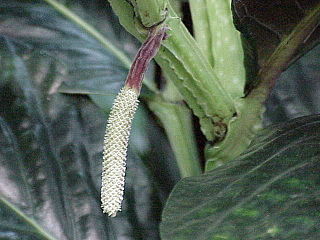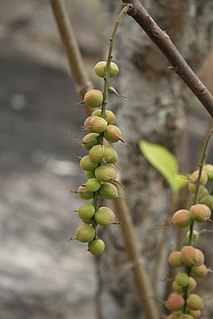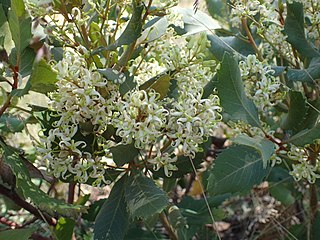
Piper, the pepper plants or pepper vines, is an economically and ecologically important genus in the family Piperaceae.

Conocarpus erectus, commonly called buttonwood or button mangrove, is a mangrove shrub in the family Combretaceae. This species grows on shorelines in tropical and subtropical regions around the world.

Prosopis glandulosa, commonly known as honey mesquite, is a species of small to medium-sized, thorny shrub or tree in the legume family (Fabaceae).

Santalum album, or Indian sandalwood, is a small tropical tree, and the traditional source of sandalwood oil. It is native to southern India and Southeast Asia. It is considered sacred in some religions, and some cultures place great significance on its fragrant and medicinal qualities. However, the high value of the species has caused over-exploitation, to the point where the wild population is vulnerable to extinction. Indian sandalwood still commands high prices for its essential oil owing to its high alpha santalol content, but due to lack of sizable trees it is no longer used for fine woodworking as before. The plant is long-lived, but harvest is only viable after many years.
Alchornea floribunda is a plant native to tropical Africa. The plant is locally known as Niando.

Myoporum sandwicense, commonly known as naio, bastard sandalwood or false sandalwood is a species of flowering plant in the figwort family, Scrophulariaceae. It is a tree or shrub highly variable in its form, the size and shape of its leaves, in the number of flowers in a group and in the shape of its fruit. It is endemic to Hawaiʻi.

Alchornea cordifolia is a shrub or small tree distributed throughout tropical Africa, it can grow up to 8 metres tall. The plant is used in traditional African medicine. Common name is the Christmas bush.

Dichrostachys cinerea, known as sicklebush, Bell mimosa, Chinese lantern tree or Kalahari Christmas tree, is a legume of the genus Dichrostachys in the family Fabaceae.

The flora and fauna of Mount Kenya are diverse, due to the variation in altitude, rainfall, aspect and temperature. The mountain slopes can be divided into vegetation zones, with each zone having different dominant plant species. Although many plants on Mount Kenya have local names, here they are reported only with their English and scientific names.

Lomatia fraseri, commonly known as tree lomatia, forest lomatia or silky lomatia is a plant of the family Proteaceae native to eastern Australia. It grows as a shrub or small tree, reaching 8–11 metres (26–36 ft) high, with highly variable leaves. The cream to white inflorescences appear over summer. It is found in rainforest margins, gullies and heathland in mountainous regions of Victoria and New South Wales. It regenerates from fire by regrowing from a lignotuber.

Solanum erianthum is a species of nightshade that is native to southern North America and northern South America. It has been introduced to other parts of the world and has a nearly pantropical distribution. Common names include potatotree, mullein nightshade, velvet nightshade, and salvadora. The potatoes are not the fruits of the trees, they are the leaves.

Treculia africana is a tree species in the genus Treculia which can be used as a food plant and for various other traditional uses. The fruits are hard and fibrous, can be the size of a volleyball and weight up to 8.5 kg (19 lb). Chimpanzees have been observed to use tools to break the fruits into small pieces that they can eat. The fruits contain polyphenols.

Vachellia reficiens, commonly known as red-bark acacia, red thorn, false umbrella tree, or false umbrella thorn, is a deciduous tree or shrub of the pea family (Fabaceae) native to southern Africa, often growing in an upside-down cone shape and with a relatively flat crown.

Newtonia hildebrandtii, the Lebombo wattle, is a medium-sized tree native to eastern Africa. It is a protected tree in South Africa.
Hunteria umbellata grows as either a shrub or small tree up to 22 metres (72 ft) tall, with a trunk diameter of up to 40 centimetres (16 in). Its flowers feature a white, creamy or pale yellow corolla. The fruit is yellow and smooth. Its habitat is forests from sea level to 600 metres (2,000 ft) altitude. Its numerous local medicinal uses include for fever, leprosy sores, stomach and liver problems and as an anthelmintic, especially against internal worms. Hunteria umbellata has been used as arrow poison. The plant's hard wood is used in carving and to make small tools. The species is native to an area of tropical Africa from Guinea-Bissau in the west to Angola in the south.

Tabernaemontana ventricosa is a plant in the family Apocynaceae. It grows as a shrub or small tree up to 15 metres (50 ft) tall, with a trunk diameter of up to 30 centimetres (12 in) and has white sap. Leaves are paired and crowded near the ends of branches. They are oblong, leathery and a glossy dark green. Flowers are fragrant with white, somewhat twisted lobes, often with a pale yellow center and are set in small clusters at the ends of branches. The fruit is dark green, set in spreading pairs of ellipsoids or oval, beaked pods, up to 10 centimetres (4 in) in diameter. Its habitat is forests from sea level to 1,850 metres (6,000 ft) altitude. In Zimbabwe, it is usually found as part of the understorey of evergreen forests. Local medicinal uses include the treatment of wounds, fever and hypertension. The plant is native to tropical central and southern Africa.

Euclea crispa, commonly known as the blue guarri, is an Afrotropical plant species of the family Ebenaceae. The hardy and evergreen plants may form a dense stand of shrubs, or grow to tree size. It is widespread and common in the interior regions of southern Africa, and occurs northward to the tropics. Though some are present near the South African south and east coasts, they generally occur at middle to high altitudes. It is readily recognizable from its much-branched structure and dull bluish foliage colour. Those bearing lanceolate leaves may however resemble the Wild olive, another common species of the interior plateaus.
Alchornea latifolia is a species of tree in the family Euphorbiaceae. It is native to Central and South America, as well as the Caribbean, where its common names include aguacatillo, baconá and chote.

Strombosia pustulata is a species of tree in the family Olacaceae. It is native to the rainforests of tropical West and Central Africa. Common names for this tree include itako in Nigeria, afina in Ghana, poé in Abé spoken in Côte d'Ivoire and mba esogo in Equatorial Guinea.
Drypetes gerrardii is a species of small tree or large shrub in the family Putranjivaceae. Common names include forest ironplum, bastard white ironwood, and forest ironwood. It is native to tropical and subtropical central and eastern Africa. It was first described in 1920 by the English botanist John Hutchinson, who named it after the English botanist William Tyrer Gerrard who collected plants and seeds in southern Africa in the 1860s.















